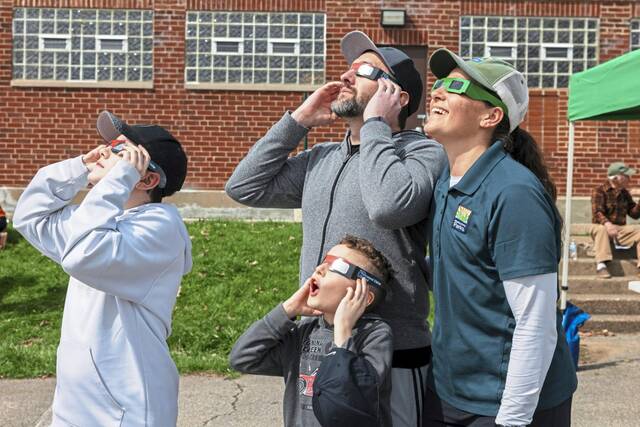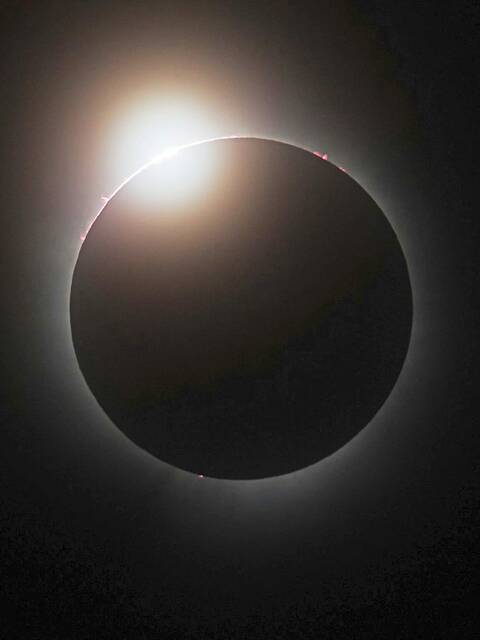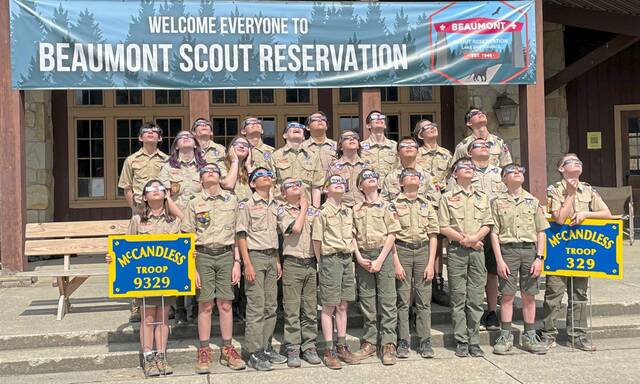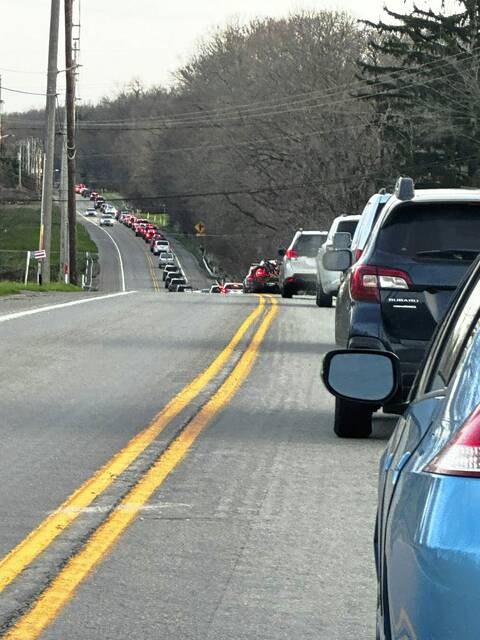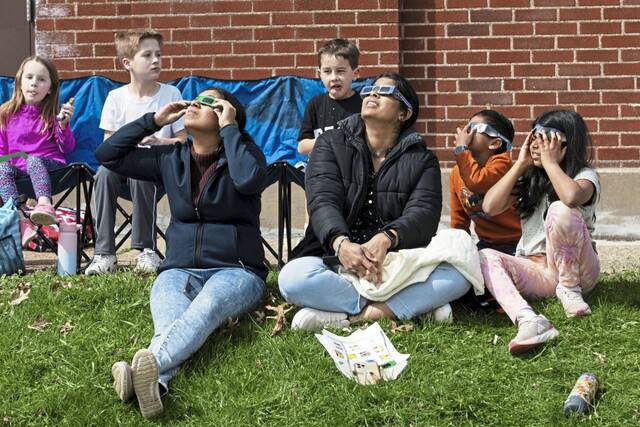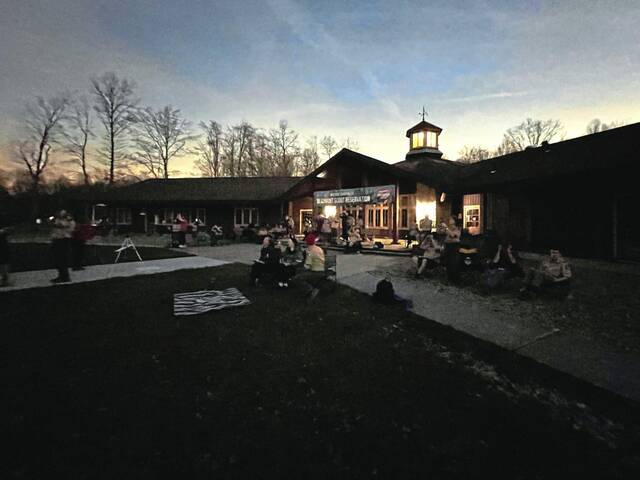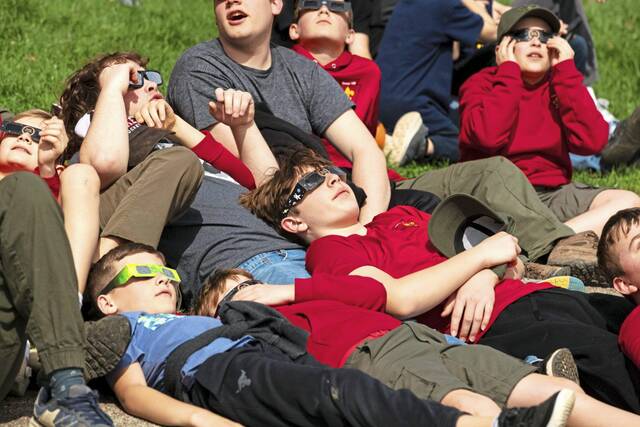‘Better than I could have imagined’: Local residents get most out of eclipse
While even being prepped with the knowledge of how astronomically unique a total solar eclipse is, North Allegheny School District science chairman Chris Omasits was still impressed beyond what he expected.
“Seeing the colors of the sky change and witnessing totality was even better than I could have imagined,” he said. “Seeing over three minutes of totality is something that I can’t describe. I had been told that even a 99% eclipse is nothing like seeing totality, and that couldn’t be more true.”
He and his family traveled April 8 to Madison, Ohio, which is on the shore of Lake Erie toward Cleveland.
As a scientist, he explained to his students how monumental the celestial event really was.
“One of the things I tried to help them appreciate is how the geometry of a total solar eclipse is so unique. Not only do the sun and moon need to line up, but the size of the sun and moon and their distances from the Earth make a total solar eclipse look as spectacular as it does,” he said.
“If the moon were smaller or further away, we would barely notice a solar eclipse. If the moon were larger or closer to us, it would block more of the light and we wouldn’t see the bright ring of the sun around the moon during the eclipse.”
It was certainly something he won’t forget.
“Getting to see my daughter, Francesca, enjoy the eclipse was really special and was a reminder how this was an amazing event, whether you’re a 7-year-old or a scientist,” Omasits said.
For those who stayed local, there was a high rate of partial moon coverage of the sun but not total. Allegheny County park rangers and staff joined visitors to watch the solar eclipse.
Jessie Dull, a naturalist at the Latodami Nature Center in North Park, said at least 155 visitors joined them at an area near the North Park swimming pool. She and fellow staff and rangers provided information on the eclipse, North Park and the Latodami Nature Center. They also distributed free eclipse solar glasses.
She said parking lots at North Park swimming pool and the adjacent playground were almost full.
“I loved the event. I was able to share my love and excitement for a rare natural phenomenon with over 100 people,” said Dull, who lives in McCandless.
“Everyone seemed to be enjoying themselves out at the park. I heard that a man on the other side of the parking lot was sharing his telescope with a solar filter, and Scout Troop 150 from Gibsonia was there earning a badge. Everyone was respectful and attentive when I walked around to announce percentages of coverage and explained what changes we were experiencing around us,” she said.
Before the big moment, the crowd was full of excitement of people talking and playing, and friends and families enjoying picnics and the park, she said.
“But, the closer we came to max coverage for our area, I noticed everyone started to slow down, get a little quieter, and began to focus on nature’s show. We all noticed it becoming darker, and the temperature cooling. During this time is when you’ll stop hearing the birds, but for our part of the park it was the humans changing from chatter to silence and soft ‘oohs’ and ‘aahs’,” she said.
Her husband, Evan, joined her for the viewing, as did their sons, Logan, 12, and Braden, 10.
“Connecting people to our nature world is my passion, and I’m so thankful to have this opportunity to reach so many people,” she said. “My husband and two boys were able to come, too, which just made the event perfect for me.”
Another momentous event of the eclipse was the traffic coming from places of totality.
BSA Troops 329 and 9329, based in McCandless, visited Camp Beaumont in Ohio for the event.
Jasun Stanton, committee chair for the troops, said it was about a two-hour drive on the way there and nearly four hours on the way back. Traffic was particularly bad on I-79 south coming off of I-80, he said.
But there was no regret.
“It was worth it for sure,” he said.
Some serious traveling will be needed for the next solar eclipse in the continental United States which is due on Aug. 23, 2044, and will shadow only three states in its path: Montana and North and South Dakota, according to NASA.
Dull likes the idea, eclipse or not.
“I’ll be 60 years old in 2044, and I’m hoping to be living in Montana by then. If I’m not living there, then I’ll plan to go. And if it ends up being cloudy, I’ll still be able to enjoy Montana’s natural beauty,” she said.
No doubt, Omasits would agree.
“I’d recommend anyone that is able to, try to travel to a path of totality sometime during their lifetime,” he said.
Natalie Beneviat is a Trib Total Media contributing writer.
Remove the ads from your TribLIVE reading experience but still support the journalists who create the content with TribLIVE Ad-Free.

